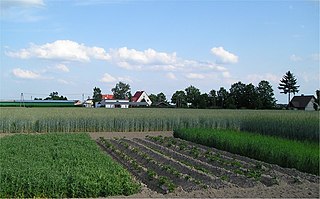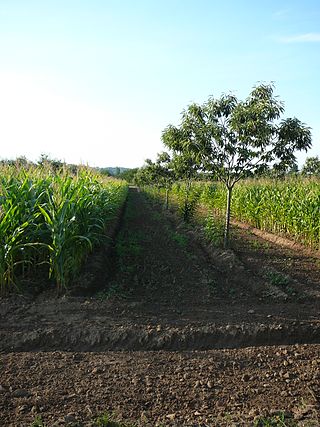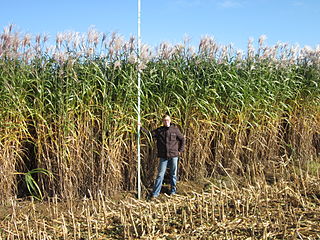Related Research Articles

Crop rotation is the practice of growing a series of different types of crops in the same area across a sequence of growing seasons. This practice reduces the reliance of crops on one set of nutrients, pest and weed pressure, along with the probability of developing resistant pests and weeds.

Intensive agriculture, also known as intensive farming, conventional, or industrial agriculture, is a type of agriculture, both of crop plants and of animals, with higher levels of input and output per unit of agricultural land area. It is characterized by a low fallow ratio, higher use of inputs such as capital, labour, agrochemicals and water, and higher crop yields per unit land area.

Sustainable agriculture is farming in sustainable ways meeting society's present food and textile needs, without compromising the ability for current or future generations to meet their needs. It can be based on an understanding of ecosystem services. There are many methods to increase the sustainability of agriculture. When developing agriculture within sustainable food systems, it is important to develop flexible business process and farming practices. Agriculture has an enormous environmental footprint, playing a significant role in causing climate change, water scarcity, water pollution, land degradation, deforestation and other processes; it is simultaneously causing environmental changes and being impacted by these changes. Sustainable agriculture consists of environment friendly methods of farming that allow the production of crops or livestock without damage to human or natural systems. It involves preventing adverse effects to soil, water, biodiversity, surrounding or downstream resources—as well as to those working or living on the farm or in neighboring areas. Elements of sustainable agriculture can include permaculture, agroforestry, mixed farming, multiple cropping, and crop rotation.

In agriculture, polyculture is the practice of growing more than one crop species together, in contrast to monoculture, which had become the dominant approach in the 20th century. Traditional examples include the intercropping of the three sisters, namely maize, beans, and squash, by indigenous peoples of Central and North America, and the rice-fish systems of Asia. Polyculture serves multiple functions in the ecology of agriculture, including controlling insect pests, plant diseases, and weeds. Polyculture can contribute to sustainable agriculture as unlike monoculture it does not rely on pesticides, requires less tillage, increases local biodiversity, and where legumes are involved, help to maintain soil nitrogen.

The Land Institute is an American nonprofit research, education, and policy organization dedicated to sustainable agriculture, based in Salina, Kansas. Their goal is to develop an agricultural system based on perennial crops that "has the ecological stability of the prairie and a grain yield comparable to that from annual crops".

No-till farming is an agricultural technique for growing crops or pasture without disturbing the soil through tillage. No-till farming decreases the amount of soil erosion tillage causes in certain soils, especially in sandy and dry soils on sloping terrain. Other possible benefits include an increase in the amount of water that infiltrates into the soil, soil retention of organic matter, and nutrient cycling. These methods may increase the amount and variety of life in and on the soil. While conventional no-tillage systems use herbicides to control weeds, organic systems use a combination of strategies, such as planting cover crops as mulch to suppress weeds.

Agroforestry is a land use management system in which combinations of trees or shrubs are grown around or among crops or pastureland. Agroforestry combines agricultural and forestry technologies to create more diverse, productive, profitable, healthy, and sustainable land-use systems. There are many benefits to agroforestry such as increasing farm profitability. In addition, agroforestry helps to preserve and protect natural resources such as controlling soil erosions, creating habitat for the wildlife, and managing animal waste. Benefits also include increased biodiversity, improved soil structure and health, reduced erosion, and carbon sequestration.

Miscanthus, or silvergrass, is a genus of African, Eurasian, and Pacific Island plants in the grass family, Poaceae.

Prairie restoration is a conservation effort to restore prairie lands that were destroyed due to industrial, agricultural, commercial, or residential development. The primary aim is to return areas and ecosystems to their previous state before their depletion.

Carbon sequestration is the process of storing carbon in a carbon pool. Carbon sequestration is a naturally occurring process but it can also be enhanced or achieved with technology, for example within carbon capture and storage projects. There are two main types of carbon sequestration: geologic and biologic.

Energy crops are low-cost and low-maintenance crops grown solely for renewable bioenergy production. The crops are processed into solid, liquid or gaseous fuels, such as pellets, bioethanol or biogas. The fuels are burned to generate electrical power or heat.

Miscanthus × giganteus, also known as the giant miscanthus, is a sterile hybrid of Miscanthus sinensis and Miscanthus sacchariflorus. It is a perennial grass with bamboo-like stems that can grow to heights of 3–4 metres (13 ft) in one season. Just like Pennisetum purpureum, Arundo donax and Saccharum ravennae, it is also called elephant grass.

Soil carbon is the solid carbon stored in global soils. This includes both soil organic matter and inorganic carbon as carbonate minerals. It is vital to the soil capacity in our ecosystem. Soil carbon is a carbon sink in regard to the global carbon cycle, playing a role in biogeochemistry, climate change mitigation, and constructing global climate models. Natural variation such as organisms and time has affected the management of carbon in the soils. The major influence has been that of human activities which has caused a massive loss of soil organic carbon. An example of human activity includes fire which destroys the top layer of the soil and the soil therefore get exposed to excessive oxidation.

Agricultural pollution refers to biotic and abiotic byproducts of farming practices that result in contamination or degradation of the environment and surrounding ecosystems, and/or cause injury to humans and their economic interests. The pollution may come from a variety of sources, ranging from point source water pollution to more diffuse, landscape-level causes, also known as non-point source pollution and air pollution. Once in the environment these pollutants can have both direct effects in surrounding ecosystems, i.e. killing local wildlife or contaminating drinking water, and downstream effects such as dead zones caused by agricultural runoff is concentrated in large water bodies.

Perennial rice are varieties of long-lived rice that are capable of regrowing season after season without reseeding; they are being developed by plant geneticists at several institutions. Although these varieties are genetically distinct and will be adapted for different climates and cropping systems, their lifespan is so different from other kinds of rice that they are collectively called perennial rice. Perennial rice—like many other perennial plants—can spread by horizontal stems below or just above the surface of the soil but they also reproduce sexually by producing flowers, pollen and seeds. As with any other grain crop, it is the seeds that are harvested and eaten by humans.
Soil management is the application of operations, practices, and treatments to protect soil and enhance its performance. It includes soil conservation, soil amendment, and optimal soil health. In agriculture, some amount of soil management is needed both in nonorganic and organic types to prevent agricultural land from becoming poorly productive over decades. Organic farming in particular emphasizes optimal soil management, because it uses soil health as the exclusive or nearly exclusive source of its fertilization and pest control.

A perennial grain is a grain crop that lives and remains productive for two or more years, rather than growing for only one season before harvest, like most grains and annual crops. While many fruit, nut and forage crops are long-lived perennial plants, all major grain crops presently used in large-scale agriculture are annuals or short-lived perennials grown as annuals. Scientists from several nations have argued that perennial versions of today's grain crops could be developed and that these perennial grains could make grain agriculture more sustainable.

Regenerative agriculture is a conservation and rehabilitation approach to food and farming systems. It focuses on topsoil regeneration, increasing biodiversity, improving the water cycle, enhancing ecosystem services, supporting biosequestration, increasing resilience to climate change, and strengthening the health and vitality of farm soil.

Soil regeneration, as a particular form of ecological regeneration within the field of restoration ecology, is creating new soil and rejuvenating soil health by: minimizing the loss of topsoil, retaining more carbon than is depleted, boosting biodiversity, and maintaining proper water and nutrient cycling. This has many benefits, such as: soil sequestration of carbon in response to a growing threat of climate change, a reduced risk of soil erosion, and increased overall soil resilience.

Carbon farming is a name for a variety of agricultural methods aimed at sequestering atmospheric carbon into the soil and in crop roots, wood and leaves. The aim of carbon farming is to increase the rate at which carbon is sequestered into soil and plant material with the goal of creating a net loss of carbon from the atmosphere. Increasing a soil's organic matter content can aid plant growth, increase total carbon content, improve soil water retention capacity and reduce fertilizer use. Carbon farming is one component of climate-smart agriculture.
References
- ↑ Berry, Wendell (5 January 2009). "A 50-Year Farm Bill". The New York Times. Retrieved 25 March 2011.
- 1 2 "The Perennialization Project: Perennials as a Pathway to Sustainable Agricultural Landscapes in the Upper Midwestern U.S." Iowa State University. Retrieved 25 March 2011.
- ↑ "Perennial agriculture | Benefits, Practices & Challenges". www.britannica.com. Retrieved 2023-12-05.
- 1 2 Monfreda, Chad; Ramankutty, Navin; Foley, Jonathan A. (March 2008). "Farming the planet: 2. Geographic distribution of crop areas, yields, physiological types, and net primary production in the year 2000". Global Biogeochemical Cycles. 22 (1). Bibcode:2008GBioC..22.1022M. doi: 10.1029/2007GB002947 . ISSN 0886-6236. S2CID 128794303.
- ↑ Ramírez-Ojeda, Gabriela; Peralta, Iris E.; Rodríguez-Guzmán, Eduardo; Chávez-Servia, José Luis; Sahagún-Castellanos, Jaime; Rodríguez-Pérez, Juan Enrique (2021-04-23). "Climatic Diversity and Ecological Descriptors of Wild Tomato Species (Solanum sect. Lycopersicon) and Close Related Species (Solanum sect. Juglandifolia y sect. Lycopersicoides) in Latin America". Plants. 10 (5): 855. doi: 10.3390/plants10050855 . ISSN 2223-7747. PMC 8145878 . PMID 33922706.
- ↑ Poppenwimer, Tyler; Mayrose, Itay; DeMalach, Niv (2023-11-08). "Revising the global biogeography of annual and perennial plants". Nature. 624 (7990): 109–114. arXiv: 2304.13101 . doi:10.1038/s41586-023-06644-x. ISSN 1476-4687. PMID 37938778. S2CID 260332117.
- ↑ "Perennial Grain Crop Development". The Land Institute. Retrieved 2023-12-05.
- ↑ Wagoner, Peggy; Schaeffer, Jurgen R. (January 1, 1990). "Perennial grain development: Past efforts and potential for the future". Critical Reviews in Plant Sciences. 9 (5): 381–408. Bibcode:1990CRvPS...9..381W. doi:10.1080/07352689009382298.
- ↑ Wahlquist, Asa. "Perennial crops a win for food security". The Australian. Retrieved 24 March 2011.
- 1 2 "Terrestrial Carbon Removal and Sequestration". Negative Emissions Technologies and Reliable Sequestration: A Research Agenda. National Academies Press. 2019. pp. 87–136. ISBN 978-0-309-48452-7.
- ↑ Rich, Deborah (24 November 2007). "Perennial crops: The garden that keeps giving". SFGate.com. Retrieved 25 March 2011.
- ↑ "Perennial Grain Cropping Research: Why Perennial Grain Crops?". The Land Institute. Archived from the original on 15 April 2013. Retrieved 25 March 2011.
- ↑ Zhou, X. (2010). "Perennial filter strips reduce nitrate levels in soil and shallow groundwater after grassland-to-cropland conversion". Journal of Environmental Quality. 39 (6): 2006–15. doi:10.2134/jeq2010.0151. PMID 21284298.
- ↑ Glover, J. D.; Reganold, J. P.; Bell, L. W.; Borevitz, J.; Brummer, E. C.; Buckler, E. S.; Cox, C. M.; Cox, T. S.; Crews, T. E.; Culman, S. W.; DeHaan, L. R.; Eriksson, D.; Gill, B. S.; Holland, J.; Hu, F.; Hulke, B. S.; Ibrahim, A. M. H.; Jackson, W.; Jones, S. S.; Murray, S. C.; Paterson, A. H.; Ploschuk, E.; Sacks, E. J.; Snapp, S.; Tao, D.; Van Tassel, D. L.; Wade, L. J.; Wyse, D. L.; Xu, Y. (24 June 2010). "Increased Food and Ecosystem Security via Perennial Grains". Science. 328 (5986): 1638–1639. doi:10.1126/science.1188761. PMID 20576874. S2CID 130815466.
- ↑ Dohleman, Frank G.; Long, Stephen P. (August 2009). "More Productive Than Maize in the Midwest: How Does Miscanthus Do It?". Plant Physiology. 150 (4): 2104–2115. doi:10.1104/pp.109.139162. PMC 2719137 . PMID 19535474.
- ↑ Zan, Claudia S; Fyles, James W; Girouard, Patrick; Samson, Roger A (2001-08-01). "Carbon sequestration in perennial bioenergy, annual corn and uncultivated systems in southern Quebec". Agriculture, Ecosystems & Environment. 86 (2): 135–144. doi:10.1016/S0167-8809(00)00273-5. ISSN 0167-8809.
- ↑ Jackson, L. E.; Pascual, U.; Hodgkin, T. (2007-07-01). "Utilizing and conserving agrobiodiversity in agricultural landscapes". Agriculture, Ecosystems & Environment. Biodiversity in Agricultural Landscapes: Investing without Losing Interest. 121 (3): 196–210. doi:10.1016/j.agee.2006.12.017. ISSN 0167-8809.
- ↑ Rouw, Anneke de; Soulilad, B.; Phanthavong, K.; Dupin, B. (2005). "The adaptation of upland rice cropping to ever-shorter fallow periods and its limit". In Bouahom, B.; Glendinning, A.; Nilsson, S.; Victor, M. (eds.). Poverty reduction and shifting cultivation stabilization in the uplands of Lao PDR. CiteSeerX 10.1.1.538.3332 . hdl:10568/37412. OCLC 169891017.